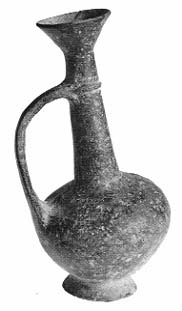Image Details

Courtesy Israel Department of Antiquities and Museums
A bilbil by any other name would look just as strange, but at least another name might be less mysterious. The origin of this popular term for a type of Cypriot-made, pottery jug and juglet remains unknown. The example shown here, found in a tomb at Gezer and dated to Late Bronze II A (1400–1300 B.C.), exhibits the striking characteristics of its type: a globular body set on a flaring ring base, a long tilting neck that narrows slightly to a flaring mouth, and a strap handle. Bilbil production began in the 16th century B.C.; bilbils became a popular export to Egypt, Palestine and the northern Levantine coast during the next two centuries.
